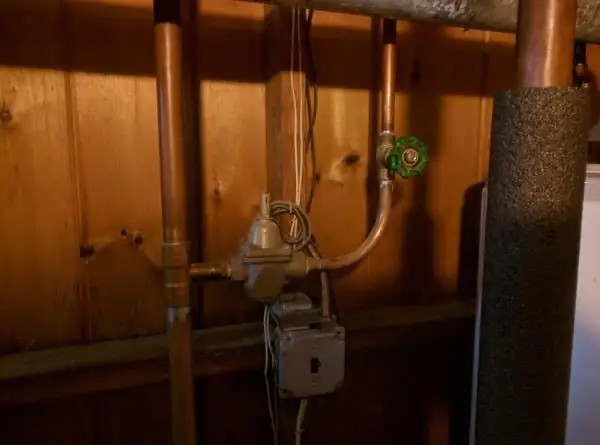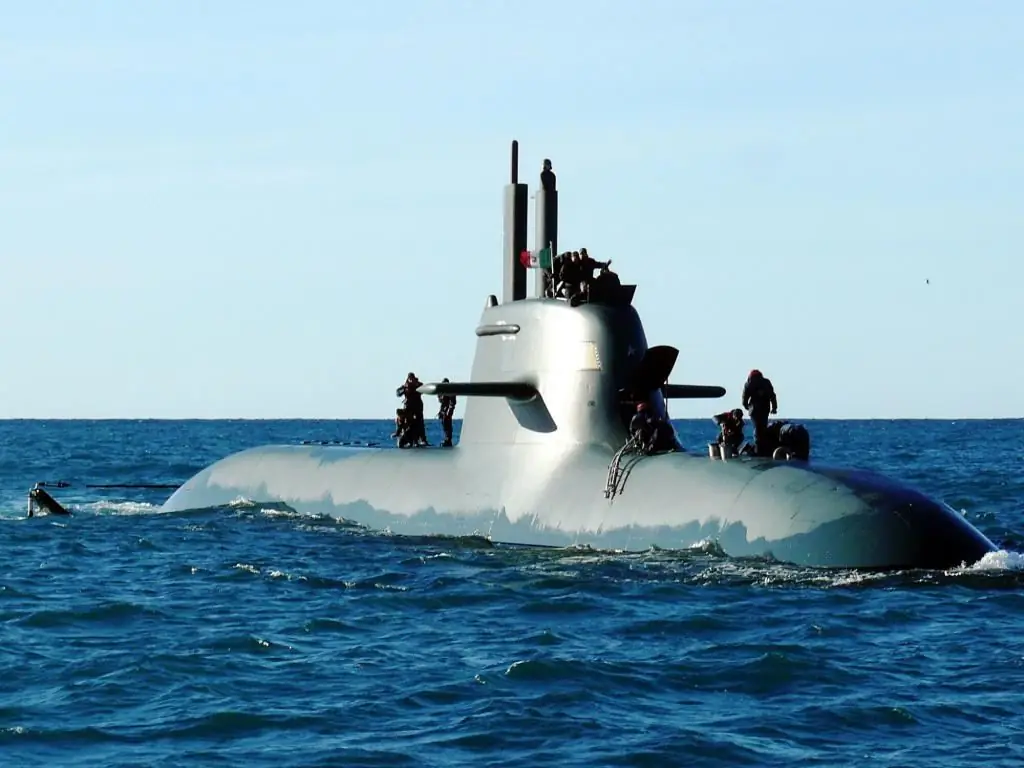2026 Author: Howard Calhoun | [email protected]. Last modified: 2025-01-24 13:10:30
Today, communication between different cities, passenger transportation, delivery of goods is carried out in a variety of ways. One of these ways was the railroad. The 2ES6 electric locomotive is one of the modes of transport that is currently actively used.
General description and creation of the first machines
From the name it becomes clear that this locomotive is operated only on those lines where there is a direct current. As for the manufacture of this transport, it is manufactured and assembled at the Ural Railway Engineering Plant. Location of production facilities - the city of Verkhnyaya Pyshma. The full name of the electric locomotive is 2ES6 "Sinara". The prefix "Sinara" comes from the owners of the company, which is a CJSC and is called the "Sinara Group".
If we talk about the history of creation, it began in 2006. After the first model successfully passed all the tests, the first 8 2ES6 electric locomotives were produced, and also in that year a contract was signed withmanufacturer and Russian Railways. The first production year for these locomotives was 2008, during which 10 more vehicles were produced. The following year, the production volume increased and another 16 2ES6 electric locomotives were delivered to Russian railways. During the following years, the volumes increased steadily and soon reached 100 locomotives per year. The increase in the pace of mechanical engineering continued until 2016.
After that, production was stabilized and the pace of construction was reduced. By the middle of 2017, for example, a total of 704 models of the 2ES6 Sinara electric locomotive had been produced from the factory.

Description of locomotive model, general technical parameters
The new locomotive model consisted of two identical sections. They were coupled by the sides, and also had intercarriage transitions. As for the control, it is carried out only from one cabin, and the sections themselves can be separated. In case of disconnection, each section of the 2ES6 "Sinara" electric locomotive becomes an independent part.
Besides, it is possible to connect two such locomotives. In this case, they form a four-section locomotive. However, this is not all. It is quite possible to add just one to a two-section locomotive to get a three-section transport. All these options are united by the fact that in any case, control will be carried out from one cabin.
It is worth noting that when using each section as an independent one, machinists often have difficulties,associated with limited visibility.
As for the general technical indicators, they are as follows:
- the speed of the 2ES6 electric locomotive, the photo of which will be presented, is 120 km/h;
- the total length of the locomotive is 34 meters;
- operation is carried out on a direct current type, as well as on a voltage of 3 kV;
- axial formula of electric locomotive 2 (20-20);
- hourly power of TED is 6440 kW;
- load per rail 25 TS.

Advantages, disadvantages, structure
The electric locomotive of this manufacturer has one significant advantage over other models of the VL type electric locomotive. This plus lies in the fact that during operation the 2ES6 electric locomotive, the photo of which was presented, receives independent traction excitation. This leads to the fact that the locomotive's traction control properties increase. In addition, during braking, the microprocessor technology of the electric locomotive regulates the voltage. A small amount of sand thrown onto the rails makes braking even more effective.
The 2ES6 has 3 stages of brake rheostat, as in its predecessor. This design allows braking quite smoothly, without sudden voltage surges. As another small plus, the following can be noted - an independent excitation was established. This plays a very important role, especially when starting a rheostat motor. This feature allows you to get rid of sudden voltage surges at times of increasespeed.
As for the malfunctions of the 2ES6 electric locomotive and its shortcomings, most often these are the following 2 reasons:
- frequent burnouts of TED anchors;
- Power contactors and auxiliary machines fail frequently.
And what is known about its design? It’s worth starting with the locomotive cab, which is made in the form of a one-piece metal structure. TED suspension is carried out with the help of motor-axial rolling bearings. As for the traction force exerted by an electric locomotive on the rails, it is equal to 25 TS, which is considered normal and generally accepted indicators for a locomotive of such power.

The purpose of the electric locomotive and the possibility of combining
The 2ES6 series electric freight locomotive with a commutator traction electric motor is intended for use in freight traffic on the railways of Russian Railways JSC with a gauge of 1520 mm. In addition, the lines must be electrified for direct current, the rated operating voltage must be 3000 V in a temperate climate.
If we talk about a two-section design, then we mean the presence of two head sections. The control of the 2ES6 electric locomotive, according to the operating rules, can be provided from any cabin. In addition, each of them must be equipped with everything necessary to ensure control.
Two-section design with a booster zone implies the presence of two head sections and one booster, and with the possibility of transition from one head section to another justthrough the booster zone.
If the locomotive is combined into a three-section or four-section, then the possibility of moving inside the body from the head to the tail will be impossible.

Detailed technical parameters
The rules of operation have clear values for all the technical characteristics of this locomotive. In addition, the data are indicated for both two-section, and for three-section, and four-section. The main data is given below:
- The current collector of the 2ES6 electric locomotive is designed for a rated operating voltage of 3 kV.
- The gauge for the passage of the train should be 1520 mm.
- The axial formula, which was specified earlier for two sections, will remain the same even in the case of a three-section or four-section execution. Only the first coefficient will change by 3 or 4 respectively.
- The load from the wheelset of this locomotive in any version will be approximately 245 kN with an error of 4.9 kN in either direction.
- The locomotive gear ratio is 3.44.
- The service weight of an electric locomotive with 0.7 tons of sand will be 200 for a two-section and 300/400 for a three- and four-section, respectively.
- Next, it is important to pay attention to the power of the traction motor shafts. For a two-section it should be at least 6440 kW, for a three-section - 9660 kW, for a four-section - 12880 kW.
- Traction force, measured in kN, for two sections - 464, for three - 696,for four - 928.
The above power and traction force are relevant for the operation of an electric locomotive in hourly mode. If the operation mode is changed to continuous, then the parameters will be as follows:
- Power will be 6000, 9000 and 12000 for two, three and four sections respectively.
- Traction force will be 418, 627, 836 kN for sections.
The entire list of rolling stock of the 2ES6 electric locomotive can be easily found online. It lists all the depots and railways on which this or that train is operated.

Production and installation of equipment
As for the manufacture of the electric locomotive itself, as well as all its equipment, it passes under the climatic version "U", which means - a temperate climate. Also locomotive and equipment placement categories - 1, 2, 3.
All equipment that will be installed outside the enclosure must be executed under the terms of V1. The equipment mounted in the body is carried out according to the U2 rules, but on the condition that the ambient air temperature does not exceed +60 degrees Celsius. Equipment manufactured according to U3 rules must be installed inside the cabin, and the working upper temperature value is also +60 degrees Celsius. The electric locomotive and equipment have another limitation regarding the maximum operating altitude above sea level, which is 1.3 km.
Here it is worth adding that equipment made according to climatic conditionsU1 and U2, allows frost to fall and then thaw.
Further, it should be noted that all the main equipment from the list of electric locomotive 2ES6 is divided into three categories depending on the mechanical factors under which they can be operated. Mechanical loads include vibration and shock loads. For the unsprung part of the units, this is the M25 group, the M26 group includes equipment located on the electric locomotive bogies. All equipment inside the locomotive body belongs to the M27 category. All these groups are accepted in accordance with GOST 17516.1-90.

Application of 2ES6 on Oktyabrskaya railway
In 2018, 2ES6 electric locomotives arrived at the Oktyabrskaya railway. For this highway, they have become fundamentally new models. Two-section models of these locomotives were sent here. After carrying out traction and energy tests, it was confirmed that it was possible to increase the mass of trains by 40%.
Reviews about the electric locomotive 2ES6 on the Oktyabrskaya railway are only positive. This is due to the fact that putting them into operation has led to the possibility of increasing the mass of trains in such directions as Babaevo-Luzhskaya and Babaevo-St. Petersburg, from the previous 6.5 to 8 thousand tons.
The station staff noted the excellent design and technical solutions, which led to the possibility of increasing the mass. In addition, testing at this station showed that it is now possible to increase throughput, while reducing operating costs formaintenance of the locomotive fleet. In addition, another significant advantage noted by the drivers and other employees is the saving of specific energy consumption by 7-15% compared to previous trains.

Placement of equipment by locomotive
Location of all equipment is quite an important process, since it is necessary to install a large amount of equipment and at the same time leave free space for the personnel operating the train. In this regard, devices are mounted in cabins, high-voltage chambers, machine rooms and even on the roof. It is possible to place some units under the body of the electric locomotive and in its end walls.
The correct layout of the body and the placement of all equipment should also provide accessibility for maintenance personnel to inspect or repair the 2ES6 electric locomotive. Plus, all units must be installed in accordance with all safety rules and comply with industrial sanitation safety measures.
It is worth noting here that the body of the electric locomotive of this model is divided into compartments in the vertical and horizontal planes.
In the vertical, the following parts can be distinguished: a compartment for roof and in-body equipment, as well as equipment located under the body.
The horizontal plane includes the vestibule, the driver's compartment, the transition platform and the engine room with a high-voltage chamber.
UKTOL at 2ES6
UKTOL is a unified set of braking equipment. Pneumatic brakethe system on the 2ES6 electric locomotive consists of two main parts - an automatic brake and an auxiliary brake for the locomotive. This pneumatic system provides the possibility of not only service braking, but also emergency, auto-stop, as well as braking in case of unforeseen separation of sections.
In addition, there is a remote control of the brakes of the electric locomotive. UKTOL on an electric locomotive 2ES6 is a complex consisting of control bodies. All of them are located on the control panel of the driver of a unified type. The main and only task of the complex is the control of the pneumatic brake system.
Work of electric locomotive parts
This locomotive consists of many parts that perform their functions. The fail-safe operation of all parts sets the electric locomotive in motion.
Start with carts. Each of the transport sections includes the presence of a two-base bogie, on which the body frame rests. In addition, the carts will take traction and braking forces. It itself consists of a welded box-section frame.
The trolley has a frame that is designed for transmission, as well as further distribution of the vertical load.
The wheel-motor block was used for the first time on this type of electric locomotive. Here, conical motor-axial rolling bearings are used, as well as a double-sided helical gear. The main feature of the wheel-motor block is that it uses a single rigid housing for two motor-axial type bearings.
Faults andrepair
Since the repair of such a complex device is a laborious and time-consuming task, it is almost never possible for personnel to carry it out on the road. For this reason, upon discovering any defect to be repaired, the driver of an electric locomotive must try to bring the train to the nearest station or convenient profile on his own inertia. Sometimes it happens that you have to make a forced stop on the rise. In this case, it is recommended to keep the train compressed, and also not to release the brakes until the electric locomotive starts moving.
After all these actions, the driver must inspect the malfunction and inform the dispatcher about the nature of the damage, the possibility of carrying out and the estimated time of repair, if possible. After that, the dispatcher must either give permission for repairs or send an additional locomotive.
Sometimes there are cases when it can take a huge amount of time to restore an electric locomotive. In these cases, the only correct solution would be to assemble an emergency circuit, which is given in the operating rules. If it is not possible to start due to a large slope, an auxiliary locomotive should be called immediately.
Recommended:
Electric motor with gearbox: features, device and principle of operation

Nowadays, it is difficult to find an industry that does not use geared motors. This unit is a kind of electromechanical independent unit in which the electric motor and gearbox work in pairs
Low pressure heaters: definition, principle of operation, technical characteristics, classification, design, operation features, application in industry

Low pressure heaters (LPH) are currently used quite actively. There are two main types that are produced by different assembly plants. Naturally, they also differ in their performance characteristics
Diesel submarines: history of creation, boat projects, principle of operation, advantages, disadvantages and stages of development

The idea of creating a submersible moving under water, actually a prototype of a submarine (hereinafter referred to as a submarine), arose long before their actual appearance in the 18th century. There are no exact descriptions of underwater vehicles in numerous legends, nor in the Renaissance genius Leonardo da Vinci
Currency of Tanzania: nominal and actual value, possible purchases, history of creation, banknote design author, description and photo

The article tells about the national currency of the African state of Tanzania. Contains information about the history of the currency, its rate in relation to other banknotes, real value, as well as a description and interesting facts about it
Moscow Locomotive Repair Plant - description, features and reviews

Moscow Locomotive Repair Plant is one of the oldest specialized enterprises in the city. The company employs qualified specialists, the work experience of many is more than 20 years. The main specialization of the plant is the repair and modernization of rolling stock

